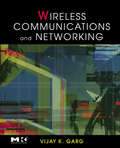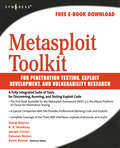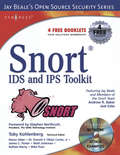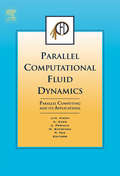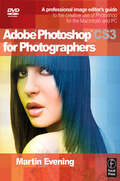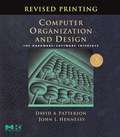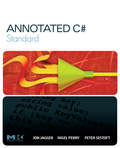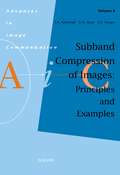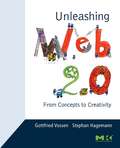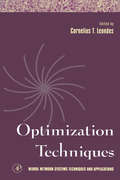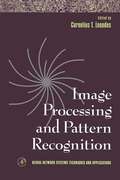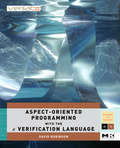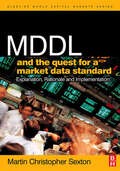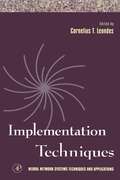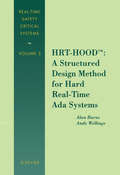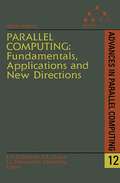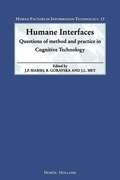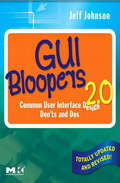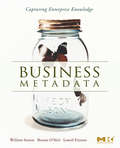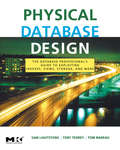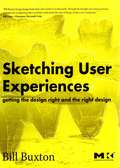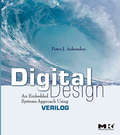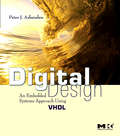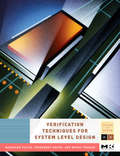- Table View
- List View
Wireless Communications & Networking (ISSN)
by Vijay GargThis book provides comprehensive coverage of mobile data networking and mobile communications under a single cover for diverse audiences including managers, practicing engineers, and students who need to understand this industry. In the last two decades, many books have been written on the subject of wireless communications and networking. However, mobile data networking and mobile communications were not fully addressed in a unified fashion. This book fills that gap in the literature and is written to provide essentials of wireless communications and wireless networking, including Wireless Personal Area Networks (WPAN), Wireless Local Area Networks (WLAN), and Wireless Wide Area Networks (WWAN). The first ten chapters of the book focus on the fundamentals that are required to study mobile data networking and mobile communications. Numerous solved examples have been included to show applications of theoretical concepts. In addition, unsolved problems are given at the end of each chapter for practice. (A solutions manual will be available.)After introducing fundamental concepts, the book focuses on mobile networking aspects. Four chapters are devoted on the discussion of WPAN, WLAN, WWAN, and internetworking between WLAN and WWAN. Remaining seven chapters deal with other aspects of mobile communications such as mobility management, security, cellular network planning, and 4G systems.A unique feature of this book that is missing in most of the available books on wireless communications and networking is a balance between the theoretical and practical concepts. Moreover, this book can be used to teach a one/two semester course in mobile data networking and mobile communications to ECE and CS students.*Details the essentials of Wireless Personal Area Networks(WPAN), Wireless Local Are Networks (WLAN), and Wireless Wide Area Networks (WWAN)*Comprehensive and up-to-date coverage including the latest in standards and 4G technology*Suitable for classroom use in senior/first year grad level courses. Solutions manual and other instructor support available
Metasploit Toolkit for Penetration Testing, Exploit Development, and Vulnerability Research
by David MaynorMetasploit Toolkit for Penetration Testing, Exploit Development, and Vulnerability Research is the first book available for the Metasploit Framework (MSF), which is the attack platform of choice for one of the fastest growing careers in IT security: Penetration Testing. The book will provide professional penetration testers and security researchers with a fully integrated suite of tools for discovering, running, and testing exploit code.This book discusses how to use the Metasploit Framework (MSF) as an exploitation platform. The book begins with a detailed discussion of the three MSF interfaces: msfweb, msfconsole, and msfcli .This chapter demonstrates all of the features offered by the MSF as an exploitation platform. With a solid understanding of MSF’s capabilities, the book then details techniques for dramatically reducing the amount of time required for developing functional exploits.By working through a real-world vulnerabilities against popular closed source applications, the reader will learn how to use the tools and MSF to quickly build reliable attacks as standalone exploits. The section will also explain how to integrate an exploit directly into the Metasploit Framework by providing a line-by-line analysis of an integrated exploit module. Details as to how the Metasploit engine drives the behind-the-scenes exploitation process will be covered, and along the way the reader will come to understand the advantages of exploitation frameworks. The final section of the book examines the Meterpreter payload system and teaches readers to develop completely new extensions that will integrate fluidly with the Metasploit Framework.A November 2004 survey conducted by "CSO Magazine" stated that 42% of chief security officers considered penetration testing to be a security priority for their organizationsThe Metasploit Framework is the most popular open source exploit platform, and there are no competing books
Snort Intrusion Detection and Prevention Toolkit
by Jay Beale Andrew Baker Brian CaswellThis all new book covering the brand new Snort version 2.6 from members of the Snort developers team.This fully integrated book and Web toolkit covers everything from packet inspection to optimizing Snort for speed to using the most advanced features of Snort to defend even the largest and most congested enterprise networks. Leading Snort experts Brian Caswell, Andrew Baker, and Jay Beale analyze traffic from real attacks to demonstrate the best practices for implementing the most powerful Snort features. The book will begin with a discussion of packet inspection and the progression from intrusion detection to intrusion prevention. The authors provide examples of packet inspection methods including: protocol standards compliance, protocol anomaly detection, application control, and signature matching. In addition, application-level vulnerabilities including Binary Code in HTTP headers, HTTP/HTTPS Tunneling, URL Directory Traversal, Cross-Site Scripting, and SQL Injection will also be analyzed. Next, a brief chapter on installing and configuring Snort will highlight various methods for fine tuning your installation to optimize Snort performance including hardware/OS selection, finding and eliminating bottlenecks, and benchmarking and testing your deployment. A special chapter also details how to use Barnyard to improve the overall performance of Snort. Next, best practices will be presented allowing readers to enhance the performance of Snort for even the largest and most complex networks. The next chapter reveals the inner workings of Snort by analyzing the source code. The next several chapters will detail how to write, modify, and fine-tune basic to advanced rules and pre-processors. Detailed analysis of real packet captures will be provided both in the book and the companion material. Several examples for optimizing output plugins will then be discussed including a comparison of MySQL and PostrgreSQL. Best practices for monitoring Snort sensors and analyzing intrusion data follow with examples of real world attacks using: ACID, BASE, SGUIL, SnortSnarf, Snort_stat.pl, Swatch, and more.The last part of the book contains several chapters on active response, intrusion prevention, and using Snort’s most advanced capabilities for everything from forensics and incident handling to building and analyzing honey pots.This fully integrated book and Web toolkit covers everything all in one convenient package It is authored by members of the Snort team and it is packed full of their experience and expertiseIncludes full coverage of the brand new Snort version 2.6, packed full of all the latest information
Parallel Computational Fluid Dynamics 2006: Parallel Computing and its Applications
by J. Periaux P. Fox A. Ecer N. Satofuka J. H. KwonThe proceedings from Parallel CFD 2006 covers all aspects of parallel computings and its applications. Although CFD is one of basic tools for design procedures to produce machineries, such as automobiles, ships, aircrafts, etc., large scale parallel computing has been realized very recently, especially for the manufactures. Various applications in many areas could be experienced including acoustics, weather prediction and ocean modeling, flow control, turbine flow, fluid-structure interaction, optimization, heat transfer, hydrodynamics.- Report on current research in the field in an area which is rapidly changing - Subject is important to all interested in solving large fluid dynamics problems - Interdisciplinary activity. Contributions include scientists with a variety of backgrounds
Adobe Photoshop Cs3 For Photographers: A Professional Image Editor's Guide To The Creative Use Of Photoshop For The Macintosh And Pc
by Martin EveningAdobe Photoshop Cs3 For Photographers: A Professional Image Editor's Guide To The Creative Use Of Photoshop For The Macintosh And Pc
by Martin EveningComputer Organization and Design, Revised Printing: The Hardware/Software Interface (ISSN)
by David A. Patterson John L. HennessyWhat’s New in the Third Edition, Revised Printing The same great book gets better! This revised printing features all of the original content along with these additional features:• Appendix A (Assemblers, Linkers, and the SPIM Simulator) has been moved from the CD-ROM into the printed book• Corrections and bug fixesThird Edition featuresNew pedagogical features• Understanding Program Performance - Analyzes key performance issues from the programmer’s perspective • Check Yourself Questions - Helps students assess their understanding of key points of a section • Computers In the Real World - Illustrates the diversity of applications of computing technology beyond traditional desktop and servers • For More Practice - Provides students with additional problems they can tackle • In More Depth - Presents new information and challenging exercises for the advanced student New reference features • Highlighted glossary terms and definitions appear on the book page, as bold-faced entries in the index, and as a separate and searchable reference on the CD. • A complete index of the material in the book and on the CD appears in the printed index and the CD includes a fully searchable version of the same index. • Historical Perspectives and Further Readings have been updated and expanded to include the history of software R&D. • CD-Library provides materials collected from the web which directly support the text. In addition to thoroughly updating every aspect of the text to reflect the most current computing technology, the third edition • Uses standard 32-bit MIPS 32 as the primary teaching ISA. • Presents the assembler-to-HLL translations in both C and Java. • Highlights the latest developments in architecture in Real Stuff sections: - Intel IA-32 - Power PC 604 - Google’s PC cluster - Pentium P4 - SPEC CPU2000 benchmark suite for processors - SPEC Web99 benchmark for web servers - EEMBC benchmark for embedded systems - AMD Opteron memory hierarchy - AMD vs. 1A-64 New support for distinct course goals Many of the adopters who have used our book throughout its two editions are refining their courses with a greater hardware or software focus. We have provided new material to support these course goals: New material to support a Hardware Focus • Using logic design conventions • Designing with hardware description languages • Advanced pipelining • Designing with FPGAs • HDL simulators and tutorials • Xilinx CAD tools New material to support a Software Focus • How compilers work • How to optimize compilers • How to implement object oriented languages • MIPS simulator and tutorial • History sections on programming languages, compilers, operating systems and databases On the CD• NEW: Search function to search for content on both the CD-ROM and the printed text• CD-Bars: Full length sections that are introduced in the book and presented on the CD • CD-Appendixes: Appendices B-D • CD-Library: Materials collected from the web which directly support the text • CD-Exercises: For More Practice provides exercises and solutions for self-study• In More Depth presents new information and challenging exercises for the advanced or curious student • Glossary: Terms that are defined in the text are collected in this searchable reference • Further Reading: References are organized by the chapter they support • Software: HDL simulators, MIPS simulators, and FPGA design tools • Tutorials: SPIM, Verilog, and VHDL • Additional Support: Processor Models, Labs, Homeworks, Index covering the book and CD contents Instructor Support
Annotated C# Standard
by Jon Jagger Nigel Perry Peter SestoftStandards, while being definitive, do not usually serve as the best reference to the use of a programming language. Books on languages usually are able to explain usage better, but lack the definitive precision of a standard. Annotated C# Standard combines the two; it is the standard with added explanatory material.Written by members of the standards committeeAnnotates the standard with practical implementation adviceThe definitive reference to the C# International Standard
Subband Compression of Images: Principles and Examples (ISSN #Volume 6)
by T.A. Ramstad S.O. Aase J.H. HusøySixth in the book series, Advances in Image Communication, which documents the rapid advancements of recent years in image communication technologies, this volume provides a comprehensive exploration of subband coding.Originally, subband coding and transform coding were developed separately. The former, however, benefitted considerably from the earlier evolution of transform coding theory and practice. Retaining their own terminology and views, the two methods are closely related and this book indeed aims to unify the approaches. Specifically, the volume contributes effectively to the understanding of frequency domain coding techniques. Many images from coding experiments are presented, enabling the reader to consider the properties of different coders.Chapter 1 introduces the problem of image compression in general terms. Sampling of images and other fundamental concepts, such as entropy and the rate distortion function, are briefly reviewed. The idea of viewing coding techniques as series expansions is also introduced. The second chapter presents signal decomposition and the conditions for perfect reconstruction from minimum representations. Chapter 3 deals with filter bank structures, primarily those displaying the perfect reconstruction property. Quantization techniques and the efficient exploitation of the bit resources are discussed from a theoretical perspective in Chapter 4 and this issue is further examined in Chapter 6, from a more practical point of view. Chapter 5 provides a development of gain formulas, i.e. quantitative measures of the performance of filter banks in a subband coding context, and these are then employed in a search for optimal filter banks. A number of examples of coded images using different subband coders are presented in Chapter 7, these indicating that subband coders give rise to some characteristic types of image degradations. Accordingly, Chapter 8 presents several techniques for minimizing these artifacts. The theory and practice of subband coding of video, at several target bit rates, is discussed in the last chapter.
Unleashing Web 2.0: From Concepts to Creativity
by Gottfried Vossen Stephan HagemannThe emergence of Web 2.0 is provoking challenging questions for developers: What products and services can our company provide to customers and employees using Rich Internet Applications, mash-ups, Web feeds or Ajax? Which business models are appropriate and how do we implement them? What are best practices and how do we apply them? If you need answers to these and related questions, you need Unleashing Web 2.0—a comprehensive and reliable resource that guides you into the emerging and unstructured landscape that is Web 2.0. Gottfried Vossen is a professor of Information Systems and Computer Science at the University of Muenster in Germany. He is the European Editor-in-Chief of Elsevier’s Information Systems—An International Journal. Stephan Hagemann is a PhD. Student in Gottfried’s research group focused on Web technologies.Presents a complete view of Web 2.0 including services and technologiesDiscusses potential new products and services and the technology and programming ability needed to realize themOffers ‘how to’ basics presenting development frameworks and best practicesCompares and contrasts Web 2.0 with the Semantic Web
Optimization Techniques (ISSN #Volume 2)
by Cornelius T. LeondesOptimization Techniques is a unique reference source to a diverse array of methods for achieving optimization, and includes both systems structures and computational methods. The text devotes broad coverage toa unified view of optimal learning, orthogonal transformation techniques, sequential constructive techniques, fast back propagation algorithms, techniques for neural networks with nonstationary or dynamic outputs, applications to constraint satisfaction,optimization issues and techniques for unsupervised learning neural networks, optimum Cerebellar Model of Articulation Controller systems, a new statistical theory of optimum neural learning, and the role of the Radial Basis Function in nonlinear dynamical systems.This volume is useful for practitioners, researchers, and students in industrial, manufacturing, mechanical, electrical, and computer engineering.Provides in-depth treatment of theoretical contributions to optimal learning for neural network systemsOffers a comprehensive treatment of orthogonal transformation techniques for the optimization of neural network systemsIncludes illustrative examples and comprehensive treatment of sequential constructive techniques for optimization of neural network systemsPresents a uniquely comprehensive treatment of the highly effective fast back propagation algorithms for the optimization of neural network systemsTreats, in detail, optimization techniques for neural network systems with nonstationary or dynamic inputsCovers optimization techniques and applications of neural network systems in constraint satisfaction
Image Processing and Pattern Recognition (ISSN #Volume 5)
by Cornelius T. LeondesImage Processing and Pattern Recognition covers major applications in the field, including optical character recognition, speech classification, medical imaging, paper currency recognition, classification reliability techniques, and sensor technology. The text emphasizes algorithms and architectures for achieving practical and effective systems, and presents many examples. Practitioners, researchers, and students in computer science, electrical engineering, andradiology, as well as those working at financial institutions, will value this unique and authoritative reference to diverse applications methodologies.Coverage includes: Optical character recognitionSpeech classificationMedical imagingPaper currency recognitionClassification reliability techniquesSensor technology Algorithms and architectures for achieving practical and effective systems are emphasized, with many examples illustrating the text. Practitioners, researchers, and students in computer science, electrical engineering, and radiology, as wellk as those working at financial institutions, will find this volume a unique and comprehensive reference source for this diverse applications area.
Aspect-Oriented Programming with the e Verification Language: A Pragmatic Guide for Testbench Developers (ISSN #Volume .)
by David RobinsonWhat’s this AOP thing anyway, really—when you get right down to it—and can someone please explain what an aspect actually is?Aspect-Oriented Programming with the e Verification Language takes a pragmatic, example based, and fun approach to unraveling the mysteries of AOP. In this book, you’ll learn how to:• Use AOP to organize your code in a way that makes it easy to deal with the things you really care about in your verification environments. Forget about organizing by classes, and start organizing by functionality, layers, components, protocols, functional coverage, checking, or anything that you decide is important to you• Easily create flexible code that eases your development burden, and gives your users the power to quickly do what they need to do with your code• Truly create a plug-and-play environment that allows you to add and remove functionality without modifying your code. Examples include how to use AOP to create pluggable debug modules, and a pluggable module that lets you check that your testbench is still working before you begin a regression• Utilize AOP to sidestep those productivity roadblocks that seem to plague all projects at the most inconvenient of times• Discover why “return" is evil, and some other “gotchas" with the AOP features of eAll of the methodologies, tips, and techniques described in this book have been developed and tested on real projects, with real people, real schedules and all of the associated problems that come with these. Only the ones that worked, and worked well, have made it in, so by following the advice given in this book, you’ll gain access to the true power of AOP while neatly avoiding the effort of working it all out yourself.• Use AOP to organize your code in a way that makes it easy to deal with the things you really care about in your verification environments. Forget about organizing by classes, and start organizing by functionality, layers, components, protocols, functional coverage, checking, or anything that you decide is important to you• Easily create flexible code that eases your development burden, and gives your users the power to quickly do what they need to do with your code• Truly create a plug-and-play environment that allows you to add and remove functionality without modifying your code. Examples include how to use AOP to create pluggable debug modules, and a pluggable module that lets you check that your testbench is still working before you begin a regression• Utilize AOP to sidestep those productivity roadblocks that seem to plague all projects at the most inconvenient of times• Discover why “return" is evil, and some other “gotchas" with the AOP features of e
MDDL and the Quest for a Market Data Standard: Explanation, Rationale, and Implementation (The Elsevier and Mondo Visione World Capital Markets)
by Martin Christopher SextonThe aim of this book is to provide an objective vendor independent assessment of the Market Data Definition Language (MDDL), the eXtensible Mark-up Language (XML) standard for market data. Assuming little previous knowledge of the standard, or of systems networking, the book identifies the challenges and significance of the standard, examines the business and market drivers and presents decision makers with a clear, concise and jargon free read. Technical material is set off so that Systems Analysts are provided with an explanation to the standard’s business terms, context and deep hierarchical structure thus enabling them to create MDDL compliant interfaces. In this way, the book confers the knowledge to enable business and technology professionals to converse comfortably regarding financial systems integration. First book to present the business case for MDDL adoption and implementation Identifies the challenges and significance of the standard, examines the business and market drivers and presents decision makers with a clear, concise and jargon free read Technical material is set off from the text for systems analysts and provides comprehensive explanations of terms, context and deep hierarchical structure, thus enabling them to create MDDL compliant interfaces
Implementation Techniques (ISSN #Volume 3)
by Cornelius T. LeondesThis volume covers practical and effective implementation techniques, including recurrent methods, Boltzmann machines, constructive learning with methods for the reduction of complexity in neural network systems, modular systems, associative memory, neural network design based on the concept of the Inductive Logic Unit, and a comprehensive treatment of implementations in the area of data classification. Numerous examples enhance the text. Practitioners, researchers,and students in engineering and computer science will find Implementation Techniques a comprehensive and powerful reference.Recurrent methodsBoltzmann machinesConstructive learning with methods for the reduction of complexity in neural network systemsModular systemsAssociative memoryNeural network design based on the concept of the Inductive Logic UnitData classificationIntegrated neuron model systems that function as programmable rational approximators
HRT-HOOD™: A Structured Design Method for Hard Real-Time Ada Systems (ISSN #Volume 3)
by A. Burns A. WellingsThe increasing use of computers for real-time control on board spacecrafts has brought with it a greater emphasis on the development methodology used for such systems. By their nature, spacecraft control computers have to operate unattended for long periods and because of the programmatics of space, systems are subject to a long development cycle. As a result, there are two distinct concerns, the first being that the development approach guarantees functional and timing correctness, the second being that problems, particularly those associated with timing, are considered as early as possible in the spacecraft development life cycle.The European Space Agency has, for a number of years, encouraged the development of software using HOOD. It was thus a natural next step to investigate the incorporation of time within the existing HOOD framework. This has proven to be very beneficial and this book describes the approach developed by the authors for handling Hard Real-Time applications. It describes both the background scheduling theory, provides practical examples of its application to real life problems, and demonstrates how it is used in the various phases of the development of Hard Real-Time systems.
Parallel Computing: Fundamentals And Applications (ISSN #Volume 12)
by E. H. D'Hollander F. J. Peters G. R. Joubert U. Trottenberg R. VölpelThis volume gives an overview of the state-of-the-art with respect to the development of all types of parallel computers and their application to a wide range of problem areas. The international conference on parallel computing ParCo97 (Parallel Computing 97) was held in Bonn, Germany from 19 to 22 September 1997. The first conference in this biannual series was held in 1983 in Berlin. Further conferences were held in Leiden (The Netherlands), London (UK), Grenoble (France) and Gent (Belgium). From the outset the aim with the ParCo (Parallel Computing) conferences was to promote the application of parallel computers to solve real life problems. In the case of ParCo97 a new milestone was reached in that more than half of the papers and posters presented were concerned with application aspects. This fact reflects the coming of age of parallel computing. Some 200 papers were submitted to the Program Committee by authors from all over the world. The final programme consisted of four invited papers, 71 contributed scientific/industrial papers and 45 posters. In addition a panel discussion on Parallel Computing and the Evolution of Cyberspace was held. During and after the conference all final contributions were refereed. Only those papers and posters accepted during this final screening process are included in this volume. The practical emphasis of the conference was accentuated by an industrial exhibition where companies demonstrated the newest developments in parallel processing equipment and software. Speakers from participating companies presented papers in industrial sessions in which new developments in parallel computing were reported.
Humane Interfaces: Questions of Method and Practice in Cognitive Technology (ISSN #Volume 13)
by Jacob L. Mey Jonathan P. Marsh Barbara GorayskaEver since the first successful International Cognitive Technology (CT) Conference in Hong Kong in August 1995, a growing concern about the dehumanising potential of machines, and the machining potential of the human mind, has pervaded the organisers' thinking. When setting up the agenda for the Second International CT Conference in Aizu, Japan, in August of 1997, they were aware that a number of new approaches had seen the light, but that the need to integrate them within a human framework had become more urgent than ever, due to the accelerating pace of technological and commercialised developments in the computer related fields of industry and researchWhat the present book does is re-emphasize the importance of the 'human factor' - not as something that we should 'also' take into account, when doing technology, but as the primary driving force and supreme aim of our technological endeavours. Machining the human should not happen, but humanising the machine should. La Humacha should replace the Hemachine in our thinking about these matters.
GUI Bloopers 2.0: Common User Interface Design Don'ts and Dos (Interactive Technologies)
by Jeff JohnsonGUI Bloopers 2.0, Second Edition, is the completely updated and revised version of GUI Bloopers. It looks at user interface design bloopers from commercial software, Web sites, Web applications, and information appliances, explaining how intelligent, well-intentioned professionals make these mistakes – and how you can avoid them. GUI expert Jeff Johnson presents the reality of interface design in an entertaining, anecdotal, and instructive way while equipping readers with the minimum of theory. This updated version reflects the bloopers that are common today, incorporating many comments and suggestions from first edition readers. It covers bloopers in a wide range of categories including GUI controls, graphic design and layout, text messages, interaction strategies, Web site design – including search, link, and navigation, responsiveness issues, and management decision-making. Organized and formatted so information needed is quickly found, the new edition features call-outs for the examples and informative captions to enhance quick knowledge building. This book is recommended for software engineers, web designers, web application developers, and interaction designers working on all kinds of products.Updated to reflect the bloopers that are common today, incorporating many comments and suggestions from first edition readersTakes a learn-by-example approach that teaches how to avoid common errorsCovers bloopers in a wide range of categories: GUI controls, graphic design and layout, text messages, interaction strategies, Web site design -- including search, link, and navigation, responsiveness issues, and management decision-makingOrganized and formatted so information needed is quickly found, the new edition features call-outs for the examples and informative captions to enhance quick knowledge buildingHundreds of illustrations: both the DOs and the DON'Ts for each topic covered, with checklists and additional bloopers on www.gui-bloopers.com
Business Metadata: Capturing Enterprise Knowledge
by W.H. Inmon Bonnie O'Neil Lowell FrymanBusiness Metadata: Capturing Enterprise Knowledge is the first book that helps businesses capture corporate (human) knowledge and unstructured data, and offer solutions for codifying it for use in IT and management. Written by Bill Inmon, one of the fathers of the data warehouse and well-known author, the book is filled with war stories, examples, and cases from current projects. It includes a complete metadata acquisition methodology and project plan to guide readers every step of the way, and sample unstructured metadata for use in self-testing and developing skills. This book is recommended for IT professionals, including those in consulting, working on systems that will deliver better knowledge management capability. This includes people in these positions: data architects, data analysts, SOA architects, metadata analysts, repository (metadata data warehouse) managers as well as vendors that have a metadata component as part of their systems or tools.First book that helps businesses capture corporate (human) knowledge and unstructured data, and offer solutions for codifying it for use in IT and managementWritten by Bill Inmon, one of the fathers of the data warehouse and well-known author, and filled with war stories, examples, and cases from current projectsVery practical, includes a complete metadata acquisition methodology and project plan to guide readers every step of the wayIncludes sample unstructured metadata for use in self-testing and developing skills
Physical Database Design: The Database Professional's Guide to Exploiting Indexes, Views, Storage, and More (The Morgan Kaufmann Series in Data Management Systems)
by Sam S. Lightstone Toby J. Teorey Tom NadeauThe rapidly increasing volume of information contained in relational databases places a strain on databases, performance, and maintainability: DBAs are under greater pressure than ever to optimize database structure for system performance and administration. Physical Database Design discusses the concept of how physical structures of databases affect performance, including specific examples, guidelines, and best and worst practices for a variety of DBMSs and configurations. Something as simple as improving the table index design has a profound impact on performance. Every form of relational database, such as Online Transaction Processing (OLTP), Enterprise Resource Management (ERP), Data Mining (DM), or Management Resource Planning (MRP), can be improved using the methods provided in the book.The first complete treatment on physical database design, written by the authors of the seminal, Database Modeling and Design: Logical Design, Fourth EditionIncludes an introduction to the major concepts of physical database design as well as detailed examples, using methodologies and tools most popular for relational databases today: Oracle, DB2 (IBM), and SQL Server (Microsoft)Focuses on physical database design for exploiting B+tree indexing, clustered indexes, multidimensional clustering (MDC), range partitioning, shared nothing partitioning, shared disk data placement, materialized views, bitmap indexes, automated design tools, and more!
Sketching User Experiences: Getting the Design Right and the Right Design (Interactive Technologies)
by Bill BuxtonSketching User Experiences approaches design and design thinking as something distinct that needs to be better understood—by both designers and the people with whom they need to work— in order to achieve success with new products and systems. So while the focus is on design, the approach is holistic. Hence, the book speaks to designers, usability specialists, the HCI community, product managers, and business executives. There is an emphasis on balancing the back-end concern with usability and engineering excellence (getting the design right) with an up-front investment in sketching and ideation (getting the right design). Overall, the objective is to build the notion of informed design: molding emerging technology into a form that serves our society and reflects its values. Grounded in both practice and scientific research, Bill Buxton’s engaging work aims to spark the imagination while encouraging the use of new techniques, breathing new life into user experience design.Covers sketching and early prototyping design methods suitable for dynamic product capabilities: cell phones that communicate with each other and other embedded systems, "smart" appliances, and things you only imagine in your dreamsThorough coverage of the design sketching method which helps easily build experience prototypes—without the effort of engineering prototypes which are difficult to abandonReaches out to a range of designers, including user interface designers, industrial designers, software engineers, usability engineers, product managers, and othersFull of case studies, examples, exercises, and projects, and access to video clips that demonstrate the principles and methods
Digital Design (Verilog): An Embedded Systems Approach Using Verilog
by Peter J. AshendenDigital Design: An Embedded Systems Approach Using Verilog provides a foundation in digital design for students in computer engineering, electrical engineering and computer science courses. It takes an up-to-date and modern approach of presenting digital logic design as an activity in a larger systems design context. Rather than focus on aspects of digital design that have little relevance in a realistic design context, this book concentrates on modern and evolving knowledge and design skills. Hardware description language (HDL)-based design and verification is emphasized--Verilog examples are used extensively throughout. By treating digital logic as part of embedded systems design, this book provides an understanding of the hardware needed in the analysis and design of systems comprising both hardware and software components. Includes a Web site with links to vendor tools, labs and tutorials.Presents digital logic design as an activity in a larger systems design contextFeatures extensive use of Verilog examples to demonstrate HDL (hardware description language) usage at the abstract behavioural level and register transfer level, as well as for low-level verification and verification environmentsIncludes worked examples throughout to enhance the reader's understanding and retention of the materialCompanion Web site includes links to tools for FPGA design from Synplicity, Mentor Graphics, and Xilinx, Verilog source code for all the examples in the book, lecture slides, laboratory projects, and solutions to exercises
Digital Design (VHDL): An Embedded Systems Approach Using VHDL
by Peter J. AshendenDigital Design: An Embedded Systems Approach Using VHDL provides a foundation in digital design for students in computer engineering, electrical engineering and computer science courses. It takes an up-to-date and modern approach of presenting digital logic design as an activity in a larger systems design context. Rather than focus on aspects of digital design that have little relevance in a realistic design context, this book concentrates on modern and evolving knowledge and design skills. Hardware description language (HDL)-based design and verification is emphasized--VHDL examples are used extensively throughout. By treating digital logic as part of embedded systems design, this book provides an understanding of the hardware needed in the analysis and design of systems comprising both hardware and software components. Includes a Web site with links to vendor tools, labs and tutorials.Presents digital logic design as an activity in a larger systems design contextFeatures extensive use of VHDL examples to demonstrate HDL (hardware description language) usage at the abstract behavioural level and register transfer level, as well as for low-level verification and verification environmentsIncludes worked examples throughout to enhance the reader's understanding and retention of the materialCompanion Web site includes links to tools for FPGA design from Synplicity, Mentor Graphics, and Xilinx, VHDL source code for all the examples in the book, lecture slides, laboratory projects, and solutions to exercises
Verification Techniques for System-Level Design (ISSN)
by Masahiro Fujita Indradeep Ghosh Mukul PrasadThis book will explain how to verify SoC (Systems on Chip) logic designs using “formal" and “semiformal" verification techniques. The critical issue to be addressed is whether the functionality of the design is the one that the designers intended. Simulation has been used for checking the correctness of SoC designs (as in “functional" verification), but many subtle design errors cannot be caught by simulation. Recently, formal verification, giving mathematical proof of the correctness of designs, has been gaining popularity.For higher design productivity, it is essential to debug designs as early as possible, which this book facilitates. This book covers all aspects of high-level formal and semiformal verification techniques for system level designs.• First book that covers all aspects of formal and semiformal, high-level (higher than RTL) design verification targeting SoC designs.• Formal verification of high-level designs (RTL or higher).• Verification techniques are discussed with associated system-level design methodology.
